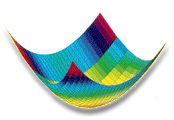Second System Identification Competition

Organised and Edited by J.J. Bloem

INTRODUCTION
After the success of the first System Identification Competition, the organisation has prepared a second even more challenging one, involving practical problems, such as solar radiation and experimental data. The previous competition, the overall results and papers on selected methods are published by the organisers in a book (January 1996). It shows that a number of methods and techniques exist and how inventive researchers can be to solve a relatively simple physical problem.
A wide range of system identification techniques is now being applied to the analysis problems involved with estimation of thermal properties of buildings and building components. Similar problems arise in most observational disciplines, including physics, biology, and economics. New commercially available software tools and special purpose computer programs promise to provide results that were unobtainable just a decade ago. Unfortunately, the realisation and evaluation of this promise has been hampered by the difficulty of making rigorous comparisons between competing techniques, particularly ones that come from different disciplines.
This new competition, that took place in 1996, has been organised to help clarify the conflicting claims among many researchers who use and analyse building energy data and to foster contact among these persons and their institutions. The intent was not necessarily only to declare winners, but rather to set up a format in which rigorous evaluations of techniques can be made. Because there are natural measures of performance, a rank ordering will be given. In all cases, however, the goal is to collect and analyse quantitative results in order to understand similarities and differences among the approaches. The performance of the techniques submitted will be compared and published very soon on this site.
The present competition is concerned with wall components and solar radiation. Four different cases are provided for estimation and prediction. Three of these cases have been designed with wall components in order to test parameter estimation methods and include different degrees of difficulty. Prediction tests are also included on experimental data. Some of the dependent variable values will be withheld from the data set in this case. Contestants are free to submit results from any number of cases.
An important aspect in the evaluation of this competition is the ability to guarantee a good quality of the analysis result of the participant.
More information
Contact J.J. Bloem
Joint Research Centre of the European Commission
Institute for Environment and Sustainability – Renewable Energies Unit
Via E. Fermi 1, TP 450
I-21020 Ispra, Italy
Tel.: +39.0332.78.9145
Fax: +39.0332.78.9992
DETAILED DESCRIPTION OF THE COMPETITION AND INSTRUCTIONS FOR ANALYSING THE DATA
Description and instructions (pdf file; 55kB)
The objective of the second competition is to set up a comparison between alternative techniques and to clarify particular problems of system identification applied to the thermal performance of buildings. The present competition is concerned with wall components and solar radiation. Four different cases are provided for estimation and prediction.
DEFINITIONS AND STATISTICAL TESTS
Definitions and statistical tests (zip file; 264kB)
Descriptions of Building-physical definitions and Mathematical definitions. To obtain a correct evaluation the organisers have defined the parameters and tests, such as the t-Test, F-Test, X2-Test, and Prediction Evaluation.
DATA
Download data of the System Identification Competition (zip file; 264kB)
